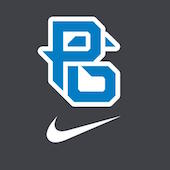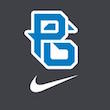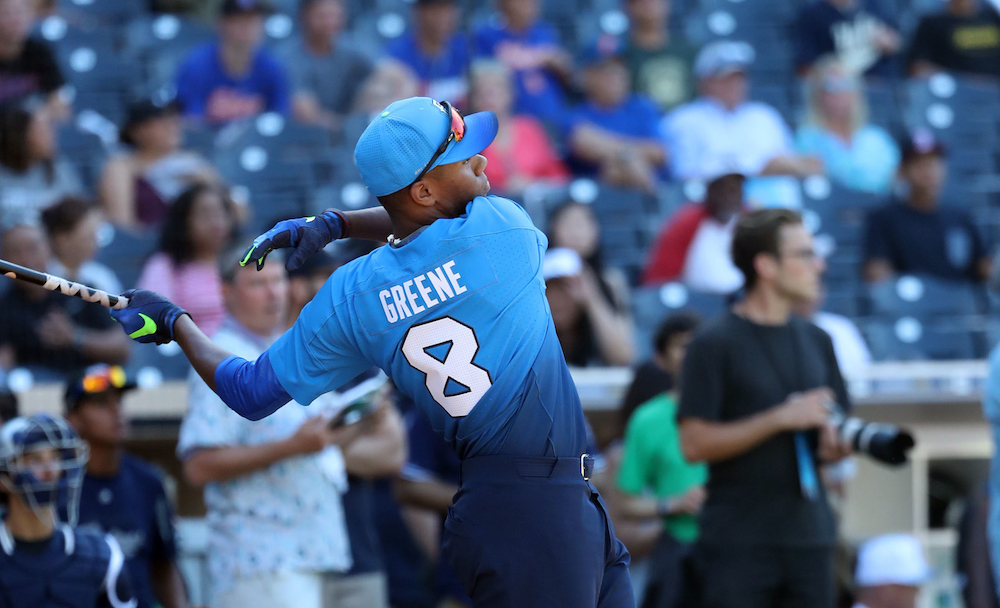Feature Photo: Hunter Greene, RHP/INF, Notre Dame (Stevenson Ranch, CA)
This year’s Perfect Game All-American Classic was the 14th iteration of the standout summer showcase, and once again it placed some of the top talents eligible for the 2017 MLB Draft class on the field at Petco Park in San Diego, CA. These five Perfect Game All-Americans were particularly impressive in my weekend’s views.
 Hans Crouse, RHP, Dana Hills (Dana Point, CA)
Hans Crouse, RHP, Dana Hills (Dana Point, CA)
Ht/Wt: 6’5″/190 B/T: R/R Age (as of 2017 Draft): 18yrs, 9m
Commit: Univ. of Southern California
Fastball: 93-to-96 (T96) – Arm-side run, tail. Straight when up in the zone. Has late life, ride up. Quick arm, ball jumps.
Curveball: 72-to-74 – 11-to-5 to 10-to-4 break; varies arm angle. Big shape, rolls, shows some finish, but inconsistent and will back up on him. Arm action plays it up; showed average.
Crouse has a long, lanky frame with a high waist and squared shoulders, showing wiry strength and above-average athleticism. He likes to mix in big turns and pauses over the rubber (including a Jhonny Cueto-esque “shimmy”) and will vary the arm angle, most regularly working out of a high-3/4 arm slot.
He has some variance in body action, and a willingness to drop down and add some funk when ahead in the count. Combines a quick arm, and the ability to create good angle when he wants, to give him some added deception, particularly when you add in all the arms and legs in the delivery. The variations get a little cute at times, and his command can suffer as a result – he can open way early and the arm tends to drag on the big turns causing the fastball to leak back out over the plate, which could hurt him against more advanced hitters. However, when he gets out front, he is able to generate above-average life down in the zone, so he’s not reliant on deception alone.
The breaking ball showed average in this look, but his execution of the pitch is inconsistent for the reasons mentioned above. There’s likely more feel for spin to come than the present feel he shows now, as he has a quick hand and will get occasional snap, but the physical strength to repeat the actions consistently is not quite there yet. Once he adds some strength – something easy to project given the body type – the actions will smooth out a bit, and the feel from different angles could really set him apart.
Crouse is still learning how to pitch, but this kid is a very uncomfortable at-bat right now, and as he grows into his body and matures in his approach, he should find more consistency from hitter-to-hitter and appearance-to-appearance. He also pitches with a bit of an edge, something that may help him as he advances. Crouse may be a long way off from this type of comparison, but Kevin Brown (RHP, MLB 1986, 88-05) comes to mind as another long, lanky guy with some funk and big arm strength who varied his looks to the hitter. If the USC commit can indeed add good strength and maintain his mobility, it is reasonable to think that the herky-jerk effort will smooth out a bit, the effectiveness will tick up, and that’s the type of upside you’re looking at.
 Hunter Greene, RHP/INF, Notre Dame (Stevenson Ranch, CA)
Hunter Greene, RHP/INF, Notre Dame (Stevenson Ranch, CA)
Ht/Wt: 6’4″/197 B/T: R/R Age (as of 2017 Draft): 17yrs, 10m
Commit: UCLA
Greene just might have the loudest tools of the entire 2017 MLB Draft given the looks we’ve seen so far this summer. There is some present strength in the body, and he stands to add a good deal more as he matures and fills out. Based on his big summer and the gushing of scouts behind the net, it sounds like a foregone conclusion that this kid is coming off the board early next June. But much like Bobby Dalbec (3B, Red Sox, Short-Season A Lowell, NY-Penn League), the Red Sox fourth-round pick in 2016, there is a legit question as to whether he’s more likely to be signed as pitcher or as a position player.
On the offensive side Greene showed easy power to the pull field – 65-to-70 grade raw power – during the Home Run Derby portion of the PG All-American Classic weekend. He repeatedly put balls into the third deck of the Metal Supply building down the left-field line of Petco Park and also reached the second deck under the big screen towards left-center field. He has a smooth load and generates tremendous backspin with what looks like minimal effort. At times his stroke will lengthen out and the bat will slow down, and he did not handle spin very well in my short look. However, it is hard to ignore that type of power potential. He has been at shortstop during his time in the field, but lacks the fast-twitch actions and good first step defensively to stay there. Greene is a fringe-average runner down the line, but has long, loping strides and is much better underway. If he signs as a position player, he seems to fit best as an offensive-minded third baseman or right fielder.
On the mound, the UCLA commit showed first-round potential as well. Green has a smooth, athletic delivery with a high-3/4 arm slot and small hook in back, and overall his mechanics are relatively simple and compact. While he does have some slight drop and drive, he manages to stay on top of the ball consistently and create some angle. His fastball worked 96-to-98 mph in this outing and exploded through the zone. While he wasn’t particularly precise to spots, he threw strikes, and showed that he can work effectively to the glove side.
The slider, working 77-to-82 mph, is a work in progress, mostly flashing average at present. He tends to get on the side of it, which forces the pitch to flatten out and work more cutter-ish, leading to more soft contact than empty swings. With the athleticism in his delivery, the arm action, and the present arm strength, the ingredients are there for his stuff and command to develop across the board. There is a lot to like here and I have to assume Greene will be atop major league teams’ wish lists when the calendar turns over.
 Nick Allen, SS, Francis Parker (San Diego, CA)
Nick Allen, SS, Francis Parker (San Diego, CA)
Ht/Wt: 5’9″/160 I B/T: R/R I Age (as of 2017 Draft): 18yrs, 7m
Commit: Univ. of Southern California
Run: 4.37 HP-to-1B – fringe-average up-the-line but good first-step quickness in the field.
As I mentioned in our PG All-American Classic preview, Allen’s defensive tools are undeniable. He is a tremendous athlete with ultra-smooth actions and a double-plus arm at shortstop. While he may be a fringe-average runner down the line, the San Diego native shows above-average first-step quickness on defense to go with excellent body control. His feet work very well around the bag and he does a terrific job getting his shoulders in line with his target to make accurate throws on the move.
At the plate, Allen already looks the part of your prototypical two-hole hitter – situationally aware, able to use the middle of the field, and not afraid to hit with two strikes. He’s already showing a strong ability to get the bat head out front and, as he gets a bit stronger, he will start seeing more carry to the gaps. Allen shows present feel for the barrel and did not look overmatched by the better breaking balls he saw over the weekend. He’ll be tough to punch out and may end up having more bat than he’s given credit for right now. He does get some hip travel, which is mildly concerning, but some of that may be attributed to him over-swinging in this showcase setting and trying to keep up with his bigger, stronger teammates. Ultimately, he is athletic enough and the actions are so good that he should be able to make adjustments going forward.
Based on what I have seen across the last two looks at the Area Code Games and the PG All-American Classic, I’m pounding the table to take this kid early next June. That said, it is not uncommon for players of similar size and build to slip some when teams make the calculation that additional strength is not a given, and that the overall profile is a bit of a reach in the top few rounds. If he is faced with a scenario wherein he slips to the third-to-fifth round and does not receive an offer large enough to buy him away from a few years with the Trojans, Allen stands to gain a heck of a lot if he goes to Southern Cal, matures physically, and hits.
Franklin Barretto (2B, A’s, Double-A Texas League) and Trevor Story (SS, Rockies) are two guys who had very good actions at the same age, but also lacked strength at the time. Both have since gotten a lot stronger and the offense has followed. While Story had a bigger frame and has grown to a different level power-wise, Barretto’s progression with the bat could be a fair mid-road comparison. Allen has defensive tools that are far superior in my opinion, so if you think his bat will come along, then there’s no question you gladly fork over the high pick – or give him that over-slot bonus – if you’re lucky enough to have him fall to your pick later on.
 Royce Lewis, CF, JSerra Catholic (San Juan Capistrano, CA)
Royce Lewis, CF, JSerra Catholic (San Juan Capistrano, CA)
Ht/Wt: 6’2″/185 B/T: R/R Age (as of 2017 Draft): 18 yrs, 0m
Commit: Univ. of California – Irvine
Run: 3.98, 4.19 HP-to-1B – can really open it up underway when his strides lengthen out.
The MVP of this year’s All-American Game, Lewis has the tools to stay in center field along with some power potential with the bat. He already has some strength to his wiry frame, with a broad set of shoulders offering plenty of room to add more. He has some present raw power – call it 50 grade – and he can drive the ball out to the big part of the field when he gets the head out. The swing will get long at times and the barrel will drag, but Lewis did seem to dial it in a bit against the top shelf velocity he faced. He is a double-plus runner who is pretty quick to full speed and has a chance to remain a threat to run, even as he gets bigger.
Lewis isn’t a low-motor guy, but has very easy actions that can be deceptive. He wasn’t overly tested in center, but he showed a good first step and some closing speed going to the gaps. He doesn’t throw particularly well, grading out as a 40 arm based on recent looks, which might be the only knock on his tool set right now. Even lacking impactful arm strength, however, Lewis still showed accuracy in workouts and demonstrated an ability to get rid of the ball quickly. Ultimately, this is a kid whose legitimate projectability and summer performance should have him lined up towards the top of 2017 draft lists. He resembles Lewis Brinson (CF, Brewers, Triple-A Colorado Springs, Pacific Coast League) at the same developmental stage, albeit with slightly shorter levers. There’s present strength, but the coordination is still in its nascent stages. A lot can happen, but the collection of tools and the looks I’ve gotten seem to point to a potential first rounder next June.
 Cole Turney, RF, William B. Travis (Richmond, TX)
Cole Turney, RF, William B. Travis (Richmond, TX)
Ht/Wt: 6’1″/205 B/T: L/L Age (as of 2017 Draft): 18 yrs, 5m
Commit: Univ. of Arkansas
Run: 4.25, 4.32 HP-to-1B – athletic, easy actions.
This was Turney’s second go-round with the PG All-American Classic, and while I wasn’t on hand for an up-close look last year, it doesn’t surprise me that he was able to compete as an underclassman against kids a year ahead of him.
Turney’s a physical kid with broad shoulders and present upper-body strength that he wields effectively. He has a bit of a crouch in his stance with a small load and a slight uphill path in the stroke. He sits back and shows good balance throughout the swing and he can really lean on balls when his timing is right. The swing is pretty easy and generates big carry to the pull side. The raw power checks in as a 55 grade presently with future 60 grade not being out of the question. Turney put together decent at-bats throughout the weekend, though he was challenged some in his handling balls on the outer half, where he did not look particularly comfortable. While this is not uncommon for a developing high school power hitter, Turney will need to get evaluators comfortable that he will eventually be able to drive the left-center field gap – a necessity in finding success at the next level.
He’s a good athlete who runs well, though defensive looks were limited since he was not tested in the outfield. He showed a 40-grade arm in pre-game with some accuracy, and I think he will be able to make enough contact at the next level to allow his power to play to the requisite level should he fit best in a corner-outfield spot long term. Because the overall physical projection is limited, it’s some belief in the hit tool (along with the present pop) that will ultimately convince evaluators he’s a worthy investment in the early rounds. Turney is one of the more interesting names to watch this coming spring, and I, for one, am curious to see how much he progresses over the coming months.




